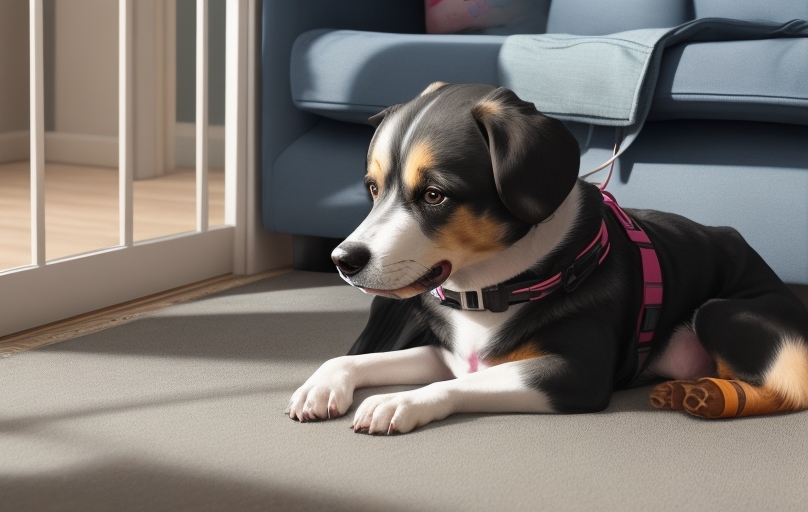If you’re a dog owner, you’ve likely encountered the challenge of How to Prepare Your Dog to Be Left at Home Alone. In today’s fast-paced world, many of us lead busy lives, juggling work, social commitments, and family responsibilities. Unfortunately, this can sometimes leave our furry companions feeling lonely and anxious when we’re not around. In this article, we will discuss how to prepare your dog for these periods of solitude, ensuring their well-being and your peace of mind.
Introduction
Leaving your dog at home alone doesn’t have to be a stressful experience for either of you. By taking a few proactive steps and understanding your dog’s needs, you can ensure they remain happy and well-adjusted in your absence.
How to Prepare Your Dog to Be Left at Home Alone
1.Understanding Your Dog’s Needs

Before we dive into the preparations, it’s essential to comprehend what your dog needs to thrive.
Physical Exercise
Dogs are active animals, and regular physical exercise is crucial for their physical and mental well-being. Ensure they get enough exercise before you leave them alone.
Mental Stimulation
Mental stimulation through toys, puzzles, and interaction is as vital as physical exercise. Engaging your dog’s mind will prevent boredom and destructive behavior.
2. Creating a Comfortable Environment

Your dog’s environment at home plays a significant role in their well-being. Make sure they have a comfortable space with access to water, toys, and a cozy resting area.
3. Gradual Training and Desensitization
Training your dog for being alone should be a gradual process, especially if they are not used to it.
Establishing a Routine
Start by establishing a daily routine. Dogs thrive on predictability, so a set schedule for feeding, playtime, and bathroom breaks is essential.
Short Absences
Begin with short absences and gradually increase the time you’re away. This helps your dog adjust to being alone without experiencing separation anxiety.
Extended Absences
As your dog becomes more accustomed to your absence, you can start leaving them alone for longer periods. Always ensure they have everything they need during your absence.
4. Interactive Toys and Treats

Interactive toys and treat-dispensing gadgets can keep your dog entertained and mentally engaged while you’re away. These items can provide hours of distraction and help reduce anxiety.
5. Hiring a Dog Sitter or Walker
If your schedule doesn’t allow you to be with your dog for extended periods, consider hiring a dog sitter or walker. Having someone check in on your furry friend can make a world of difference.
6. Monitoring Your Dog
Technology can be your ally in keeping an eye on your pet. Consider using cameras or apps to monitor your dog’s behavior when you’re not at home.
7. Calming Techniques

Incorporate calming techniques like soothing music or pheromone diffusers to create a relaxed atmosphere in your absence. These can help your dog feel more at ease.
Common Mistakes to Avoid
There are some common mistakes dog owners make when preparing their pets for alone time. Avoiding these can help ensure a smooth transition.
- Don’t make a big fuss when leaving or returning home.
- Don’t scold your dog for any accidents or destructive behavior.
- Don’t leave your dog alone for excessively long periods.
Read Also: How To Train Your Dog To Stay Home Alone
Conclusion
Leaving your dog at home alone doesn’t have to be a daunting experience. By understanding your dog’s needs, creating a comfortable environment, and following a gradual training process, you can ensure their well-being and your peace of mind. Remember, every dog is unique, so adapt these techniques to your pet’s specific needs.
FAQs
1. How long can I leave my dog alone?
The duration depends on your dog’s age, breed, and individual needs. Puppies can typically be left alone for shorter periods than adult dogs. Consult with your veterinarian for specific guidance.
2. Are there any specific toys to keep my dog engaged during my absence?
Puzzle toys, interactive feeders, and treat-dispensing toys are great options to keep your dog mentally stimulated.
3. Should I use a crate for my dog when I’m not at home?
Crates can be useful for some dogs, but it’s essential to introduce them gradually and ensure they associate the crate with a positive experience.
4. How do I know if my dog is suffering from separation anxiety?
Signs of separation anxiety may include excessive barking, destructive behavior, and house soiling. If you suspect your dog has separation anxiety, consult with a professional dog trainer or behaviorist.
5. What if my dog’s behavior doesn’t improve despite following these tips?
If your dog continues to struggle with being left alone, it’s advisable to seek advice from a professional dog trainer or a veterinarian to address any underlying issues.

2 thoughts on “How to Prepare Your Dog to Be Left at Home Alone:7 Easy Steps”